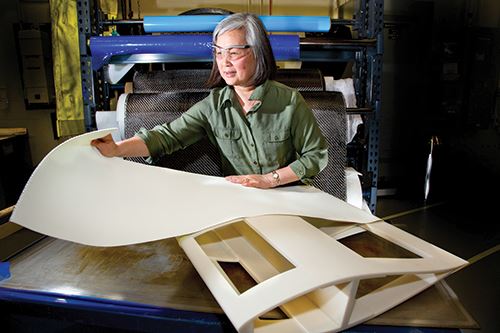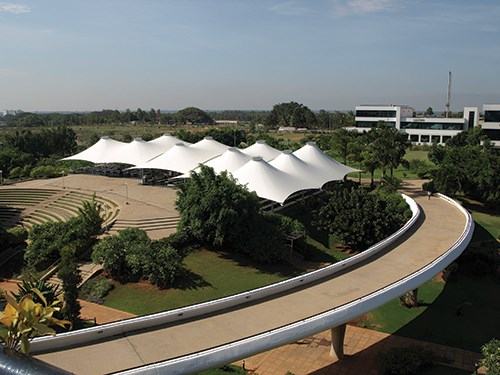A different type of blade?
GE Wind Energy and public/private partners investigate the use of resin-impregnated architectural fabrics as a substitute for conventional composite laminates in the construction of wind blade skins.
A potential paradigm shift in wind turbine blade manufacture is afoot at GE Wind Energy (Niskayuna, N.Y.). The company’s global research arm, along with Virginia Polytechnic Institute & State University (Blacksburg, Va.) and the National Renewable Energy Laboratory (Golden, Colo.), recently secured a three-year grant under the U.S. Department of Energy’s Advanced Research Projects Agency to investigate the use of resin-impregnated architectural fabrics as a substitute for conventional composite laminates in the construction of wind blade skins. In this design, as envisioned, fabric is stretched or “tensioned” around a spaceframe of stamped metal ribs.
The fabric is impregnated with resin to make it impermeable to wind and water intrusion. Wendy Lin, GE’s principal engineer and lead on the project, declines to identify the fabric; however, she stresses that the resin is neither an epoxy nor a polyester, but a “rubbery,” compliant material that allows GE to assemble the blade in large segments without risk of the blade buckling.
Lin says the impetus for the project was an internal directive at GE to reduce the cost of manufacturing wind blades by 50 percent. If the fabric is successful, GE claims the new blade design could reduce blade production costs by up to 40 percent and put wind energy on equal economic footing with fossil fuels, without government subsidies. Lin says the design would permit automotive-type precision and tolerances and eliminate the logistical problem, and associated costs, of transporting long blades to turbine sites. Instead, the blade components could be shipped in container kits and assembled on site. “We still have a ways to go to prove it out, however,” Lin admits. “Size constraints imposed by current technology require thinking outside the box.” But, she says, the concept could pave the way for blades as long as 130m/426.5 ft, making them suitable for harvesting wind in moderate wind locales.
Related Content
-
JEC World 2023 highlights: Recyclable resins, renewable energy solutions, award-winning automotive
CW technical editor Hannah Mason recaps some of the technology on display at JEC World, including natural, bio-based or recyclable materials solutions, innovative automotive and renewable energy components and more.
-
MingYang reveals 18-MW offshore wind turbine model with 140-meter-long blades
The Chinese wind turbine manufacturer surpasses its 16-MW platform, optimizes wind farm construction costs for 1-GW wind farms.
-
Infinite Composites: Type V tanks for space, hydrogen, automotive and more
After a decade of proving its linerless, weight-saving composite tanks with NASA and more than 30 aerospace companies, this CryoSphere pioneer is scaling for growth in commercial space and sustainable transportation on Earth.













.jpg;maxWidth=300;quality=90)
